You guys rock! I've been coming here for weeks identifying the birds in our backyard for my daughter's school project. Thanks so much for this valuable resource.
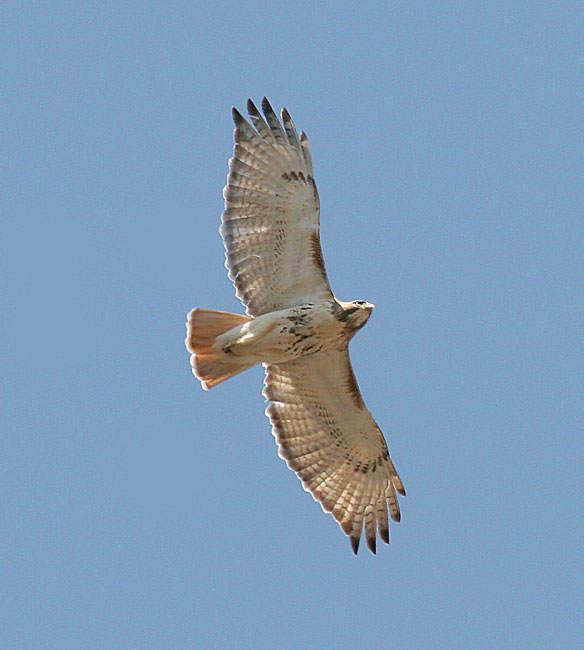
commonest hawk with reddish tail.
Birds of this species have a dark mark along the leading edge of the underwing, between the body and the wrist (the patagium). Most but not all color variations have a dark band across the belly. In most, the adults' tails are rusty red above, and juveniles have narrow brown and pale bands. The main western North American population has bands on the adults' rusty tails as well and has varied plumage, organized into three main color types or morphs.
Immature birds, or birds that are only a few years old, can also readily be identified by having yellowish pupils. As the bird attains full maturity over the course of 3-4 years, the pupils slowly darken into a reddish-brown hue.
Light-morph birds are mainly brown on the upperparts and very pale brown or buff on the underparts and underwings; they show a belly band.
Rufous-morph birds are darker and redder, with reddish-brown rather than white on the underparts. The belly band may be barely visible.
Dark-morph birds are very dark brown on both upperparts and underparts; they have lighter parts on the underwings.
Almost all of the main eastern population are light-morph, with whiter underparts and paler markings than western birds and with solid rust-red tails as adults.
Photo © Mark S. Szantyr
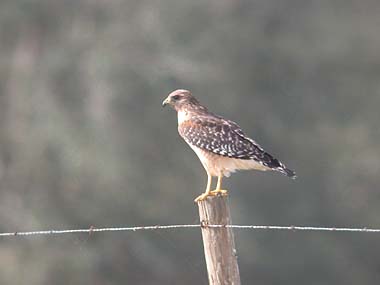
Compact hawk that can often be seen in urban parks. Reddish barred breast and red shoulder patch.
Adults have a brown head, a reddish breast and a pale belly with reddish bars. They have a long dark tail with narrow white bars. The red "shoulder" is visible when the bird is perched. Their upperparts are dark with pale spots; they have long yellow legs. Western birds may appear more red; Florida birds are generally paler.
Their breeding habitat is deciduous and mixed wooded areas near water in eastern North America and along the coast of California and northern Mexico. They build a stick nest in a major fork of a large tree.
These birds are permanent residents throughout most of their range; northern birds migrate to more southern parts of their range.
These birds wait on a perch in a forested area and swoop down on prey, also sometimes flying low through clearings to surprise prey. They mainly eat small mammals, amphibians, reptiles, small birds and large insects.
They are quite vocal, especially during spring courtship. Their cry is a loud, screaming "kee yar" dropping in pitch, typically uttered 2-4 times.
Photo © Mark Thomas
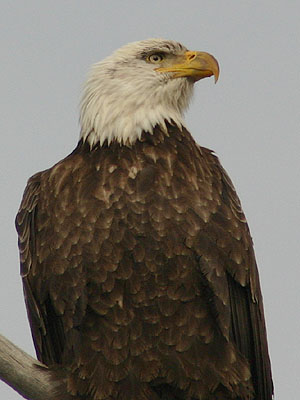
Huge bird of prey. Adults have white heads. Young birds are dark brown on head.
The Bald Eagle (Haliaeetus leucocephalus), also known as the American Eagle, is a bird of prey originating in North America, most recognizable as the national bird of the United States. The species was on the brink of extinction late in the 20th century but now has a stable population and is in the process of being removed from the U.S. federal government's list of endangered species.
The bird gets both its common and scientific names from the distinctive appearance of the adult's head. Bald in the English name refers to the white head feathers, and the scientific name is derived from Haliaeetus, the New Latin for "sea eagle," (from the Greek haliaetos) and leucocephalus, the Greek for "white head," from leukos ("white") and kephale ("head").
An immature bird has speckled brown feathers all over, the distinctive head and body plumage arriving 2–3 years later, before sexual maturity. Their life span is approximately 50 years. Adult females have a wingspan of approximately 2.1 meters (7 feet); adult males have a wingspan of 2 meters (6 feet, 6 inches). Adult females weigh approximately 5.8 kg (12.8 lb), males weigh 4.1 kg (9 lb).
Bald Eagles are protected by two federal laws in the United States: the Eagle Law, which protects Bald and Golden Eagles, and the Migratory Bird Act.
Photo © Tim Avery
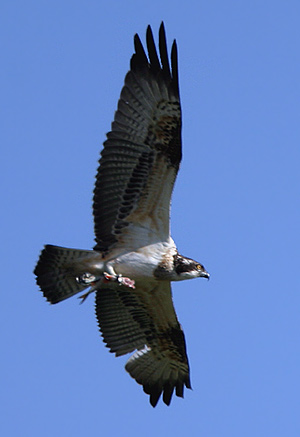
Dives in to water after fish. Large white underwings and body.
The Osprey (Pandion haliaetus) is a medium large raptor which is a specialist fish-eater with a worldwide distribution. It is often known by other colloquial names such as fishhawk, seahawk or Fish Eagle. It is the only member of the genus Pandion, which is in turn the only genus in family Pandionidae.
The Osprey is 52-60cm (20.5-23.6 inches) long with a 152-167cm (5-5.5 feet) wingspan. It has white underparts and long, narrow wings with four "finger" feathers at the end of each, which give it a very distinctive appearance.
Their call is a series of sharp, whistles, cheep, cheep, or yewk, yewk. Near the nest, a frenzied cheereek!
The Osprey is particularly well adapted to its diet, with reversible outer toes, closable nostrils to keep out water during dives, and backwards facing scales on the talons which act as barbs to help catch fish.
It locates its prey from the air, often hovering prior to plunging feet-first into the water to seize a fish. As it rises back into flight the fish is turned head forward to reduce drag. The 'barbed' talons are such effective tools for grasping fish that, on occasion, an Osprey may be unable to release a fish that is heavier than expected. This can cause the Osprey to be pulled into the water, where it may either swim to safety or succumb to hypothermia and drown.
Photo © Steve Round
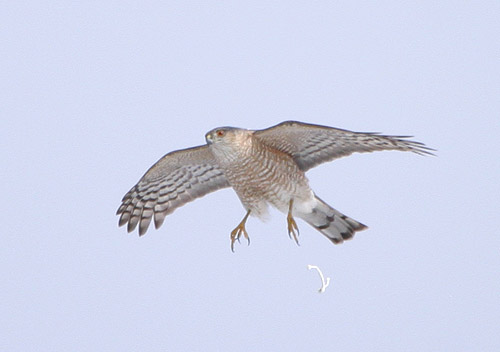
The Sharp-shinned Hawk (Accipiter striatus) is a small hawk.
Adults have short broad wings and a long square-ended tail with dark bands. They have a dark cap, blue-grey upperparts and white underparts with red bars. Mature birds have dark red eyes and yellow legs. Adult females are slightly larger. They are easily mistaken for the slightly larger and lankier Cooper's Hawk.
Their breeding habitat is forested areas across most of North America and parts of Central America, although they are more common in the boreal forest. They build a stick nest in a large conifer or dense group of deciduous trees.
In some parts of the United States, they are permanent residents. Northern birds migrate to the southern U.S. and south to South America.
These birds surprise and capture small birds from cover or while flying quickly through dense vegetation. They often pluck the feathers off their prey on a post or other perch. They also eat rodents, lizards, frogs, snakes, and large insects.
This bird declined in numbers in the 1960s and 1970s, probably as a result of the use of DDT and other pesticides. Their population rebounded since and might even exceed historical numbers today. This is probably due to the combination of the ban on DDT and the proliferation of backyard birdfeeders in North America which create unnaturally reliable and easy prey for Accipiters
Photo © Brandon Holden
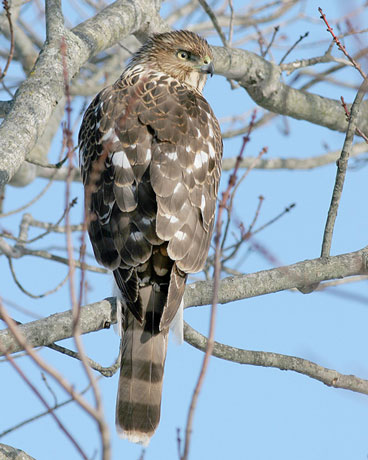
Larger than Sharp-shinned Hawk (above).
Adults have short broad wings and a long round-ended tail with dark bands. They have a dark cap, blue-grey upperparts and white underparts with red bars. They have red eyes and yellow legs. Adult females are much larger. This bird is somewhat larger than a Sharp-shinned Hawk, but smaller than a Northern Goshawk. It appears long-necked in flight.
Their breeding habitat is forested areas across southern Canada, the United States and northern Mexico. They build a stick nest in a large tree.
They are permanent residents in most of the United States. Northern birds migrate to the southern U.S. and Mexico.
These birds surprise and capture small and medium-sized birds from cover or while flying quickly through dense vegetation. They also eat small mammals such as mice and other small rodents. Other possibilities are lizards, frogs, snakes and large insects. They often pluck the feathers off their prey on a post or other perch.
Photo © Mark S. Szantyr
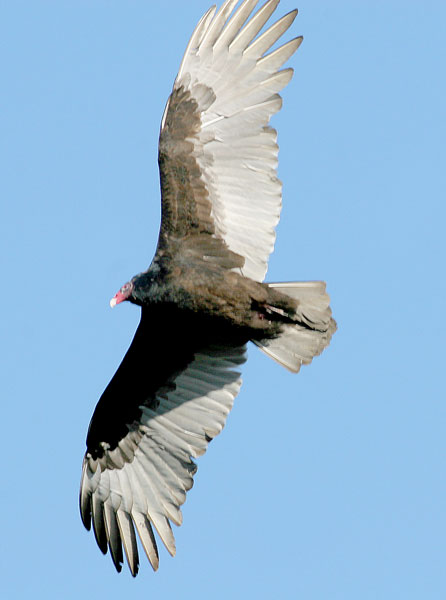
Large black raptor. Ugly red head.
The Turkey Vulture, Cathartes aura, is the most common North American vulture. It is an extremely graceful bird in flight. It seldom needs to flap its long wings once airborne, but soars high overhead looking for carcasses.
Despite the similar name and appearance, this species is unrelated to the Old World vultures in the family Accipitridae, which includes eagles, hawks, kites and harriers. The American species is a New World vulture in the family Cathartidae.
These large birds of prey are mostly brownish black, but the flight feathers are gray, creating a contrasting pattern. The head is small in proportion to the body and has no feathers on it; adults' heads are red and immatures' are black. The birds have a wing span of about 2 metres.
While soaring, they hold their wings in a V-shape and often tip "drunkenly" from side to side, sometimes causing the gray flight feathers to look silvery as they catch the light. The flight style, small-headed and narrow-winged silhouette, and underwing pattern make this bird easy to identify at great distances.The Turkey Vulture is found in open and semi-open areas throughout the Americas from southern Canada to Cape Horn. It is a permanent resident in the southern United States but northern birds may migrate as far south as South America.
These birds soar over open areas, watching for dead animals or other scavengers at work. Unlike most other birds, they also rely on smell to help locate their food. They also eat some vegetation.
Photo © Mark S. Szantyr
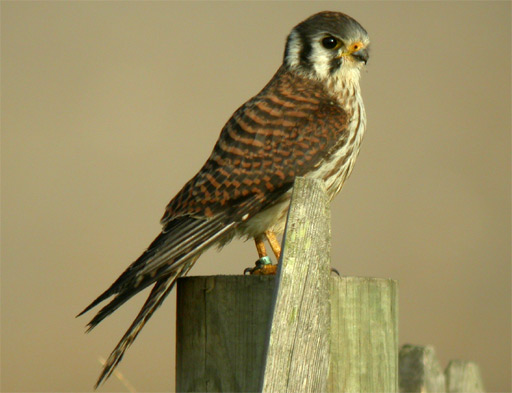
Small falcon. Male (bottom photo) has blue head and back. Female pictured above is browner. Note dark bars on side of face.
American Kestrels are a small raptor - about the size of an American Robin - and one of the few raptors where there is a color difference between the male and female. They are the smallest falcon in North America.
These tiny, seemingly fearless, birds are brightly adorned with reddish, blue and cinnamon colors. Males have blue-grey wings, cinnamon back and tail, and a chestnut patch on top of the head; the breast is white with dark spots. Females have a cinnamon body color with dark streaks, chestnut wings with black bars and vertical chestnut streaks on the light tanb reast.
Both sexes have white cheeks with two black vertical lines, one in front of the eye and one at the ear. They have long slim pointed wings, a blue-grey cap and a long chestnut tail.
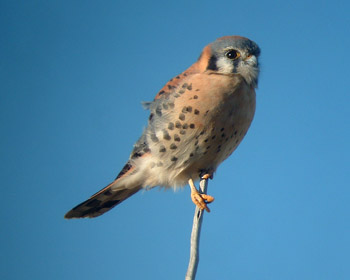
As with all raptors, the females are larger than males. However the difference is slight. The length of the birds average about 25 cm (10 inches) for females and 24 cm (nine inches) for males. Wingspans average 57 cm (22 inches) for females and 55 cm (21 inches) for males. Weights average 120 g (5 oz) for females and 111 g (3.5 oz for males.
Photo © Jim Lawrence
Photo © Robert Hughes
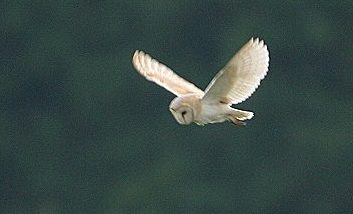
These are pale, long-winged, long-legged owls, 33-39 cm in length with an 80-95 cm wingspan. They have an effortless wavering flight as they quarter pastures or similar hunting grounds.
There are a number of races differing in underpart colour. For example, T. a. alba of western Europe is almost pure white below, but T.a. guttata of central Europe is orange. All races have grey and ochre upperparts.
These are birds of open country such as farmland, preferentially hunting along the edges of woods. They are fairly sedentary and nocturnal or crepuscular.
Barn Owls occur worldwide, on every continent except Antarctica. Sometimes they are called monkey-faced owls because of their appearance. Other common names are church owl, golden owl, rat owl, and stone owl.
Barn Owls feed on voles, frogs and insects, but are economically valuable birds as they also prey on animal pests like rats, shrews, moles and mice.
Other than human persecution, they have few predators, although large owls such as the Eurasian Eagle Owl and the Great Horned Owl will kill smaller species if the opportunity arises. Farmers often encourage Barn Owl habitations for rodent control by providing nest sites such a wooden nest box or a large drum installed sideways in a barn. An adult Barn Owl will eat approximately 3 mice per day. A pair raising 3-5 owlets will consume many more rodents.
Barn Owls have a notable shreee scream, ear-shattering at close range. They also hiss like steam kettles. When captured or cornered, they throw themselves on their backs and flail with sharp-taloned feet, an effective defence. Unlike popular belief, they do not make the call "tu-whit to-whoo".
Photos © Nigel Blake

Adults have either rusty or dark grey intricately patterned plumage with streaking on the underparts. Small and stocky, short-tailed and broad winged, they have a large round head with ear tufts, yellow eyes and a yellowish bill. Rusty birds are more common in the southern parts of the range; pairings of the two colour variants do occur. A pale grey variation also exists in western Canada and the north-central United States. The color variations are referred to as "red-phase" and "grey-phase" by bird watchers and ornithologists.
Their breeding habitat is deciduous or mixed woods in eastern North America. Usually solitary, they nest in a tree cavity, either natural or excavated by a woodpecker; they will also use nesting boxes. They are strictly nocturnal, roosting during the day in cavities or next to tree trunks.
These birds wait on a perch on low limbs in open woods and along forest edges and swoop down on prey; they may also catch insects in flight. They mainly eat large insects and small rodents, as well as small birds. They are active at night or near dusk, using their excellent hearing and night vision to locate prey.
The screech owls produce a number of different noises. The call that gives them their name is less a screech and more a spooky horse whinny. Another call they make is a quick melodic puttering that is very hard to locate. When angered, mildly threatened or otherwise offended they growl, like a miniature bulldog who has smoked too many cigarettes. Annoyed or auite upset, they will snap their bill making a little clapping noise. Some argue this clapping is actually tongue-clicking.
They are usually permanent residents; birds at the northern parts of the range may change location.
Photo © Tim Avery
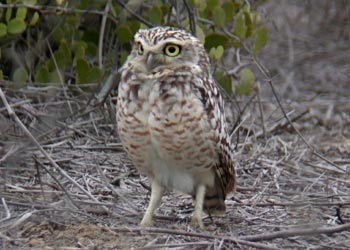
The Burrowing Owl, Athene cunicularia, is a small, long-legged owl found throughout open landscapes of North and South America.[1] There are two subspecies in North America: A. c. hypugea of southern Canada, western USA, and Mexico; and A. c. floridana of Florida and some Caribbean islands. Other subspecies are recognized in Central and South America.
Burrowing owls can be found in grasslands, rangelands, agricultural areas, deserts, or any other dry, open area with low vegetation.[2] Unlike most owls, burrowing owls are often active during the day. However, most hunting is done at night.
They are year-round residents in the southern areas of their range. Birds that breed in Canada and northern USA usually migrate south to Mexico and southern USA during winter months.
Adults have brown plumage with white spotting. The belly is white with brown bars. Their eyes and bill are yellow and they have long legs. The females are darker than the males. The average adult is slightly larger than a robin, [3] at 25 cm (10 inches) length, 53 cm (21 inches) wingspan, 170g (6 oz) weight [4]. The young owls look similar to the adults except that they have a buff bar across their wings and their chests are covered in a white to buff down.
The burrowing owl is endangered in Canada, threatened in Mexico, and a species of special concern in most of the western USA. The major reasons for declining populations are control programs for prairie dogs and loss of habitat. On the IUCN Red List, however, it is a species of Least Concern because of a large global population.
Burrowing owls are able to live for at least 9 years in the wild and over 10 years in captivity. They are often killed by vehicles when crossing roads, and have many natural enemies, including badgers, coyotes, and snakes. They are also killed by feral and domestic cats and dogs.
Photo © Mark Gurney